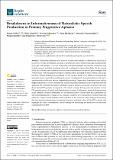Breakdowns in Informativeness of Naturalistic Speech Production in Primary Progressive Aphasia
Author(s)
Gallée, Jeanne; Cordella, Claire; Fedorenko, Evelina; Hochberg, Daisy; Touroutoglou, Alexandra; Quimby, Megan; Dickerson, Bradford C.; ... Show more Show less
Downloadbrainsci-11-00130-v2.pdf (1.834Mb)
Publisher with Creative Commons License
Publisher with Creative Commons License
Creative Commons Attribution
Terms of use
Metadata
Show full item recordAbstract
“Functional communication” refers to an individual’s ability to communicate effectively in his or her everyday environment, and thus is a paramount skill to monitor and target therapeutically in people with aphasia. However, traditional controlled-paradigm assessments commonly used in both research and clinical settings often fail to adequately capture this ability. In the current study, facets of functional communication were measured from picture-elicited speech samples from 70 individuals with mild primary progressive aphasia (PPA), including the three variants, and 31 age-matched controls. Building upon methods recently used by Berube et al. (2019), we measured the informativeness of speech by quantifying the content of each patient’s description that was relevant to a picture relative to the total amount of speech they produced. Importantly, form-based errors, such as mispronunciations of words, unusual word choices, or grammatical mistakes are not penalized in this approach. We found that the relative informativeness, or efficiency, of speech was preserved in non-fluent variant PPA patients as compared with controls, whereas the logopenic and semantic variant PPA patients produced significantly less informative output. Furthermore, reduced informativeness in the semantic variant is attributable to a lower production of content units and a propensity for self-referential tangents, whereas for the logopenic variant, a lower production of content units and relatively ”empty” speech and false starts contribute to this reduction. These findings demonstrate that functional communication impairment does not uniformly affect all the PPA variants and highlight the utility of naturalistic speech analysis for measuring the breakdown of functional communication in PPA.
Date issued
2021-01-20Department
Massachusetts Institute of Technology. Department of Brain and Cognitive SciencesPublisher
Multidisciplinary Digital Publishing Institute
Citation
Brain Sciences 11 (2): 130 (2021)
Version: Final published version